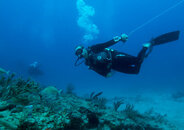One of the things my dive buddy and I didn't have any idea how to deal with was the dive flag. The didn't teach us a thing about what type to use, how to deploy it, or anything about the rules of when or how to use it. So, I thought I would explain some basic stuff about them and what we learned along the way.
We started out with the one you always see at the dive shop. Basically, and innertube wrapped in canvas with a zipper. John and I used this for the first year, and wondered the whole time if there was something easier to use. It takes two people to get that big lunker down to the water, and then you have to deal with the rope. When we started out, we had no idea how much rope we would need, so naturally we had way too much in there to deal with. We also didn't know how much weight to use at the end of the rope. One of the few advantages of this type of dive flag, is the ability to put extra dive weights in it, since as new divers, weight checks and determining how much you need is something you just have to play around with.
Eventually, after seeing what more experienced divers use as a dive flag, we downgraded (in size at least), to the type that has a styrofoam ball with a weight at the end of a rod, and the dive flag at the other end. Much easier to lug around and does the same job. Now for the configuration part. Here is what I tried out today, and it worked great:


The reel is on sale at ScubaToys.com for 15.00 bucks plus shipping. The weight is only three pounds. I'm sure in heavy winds or wave action, this won't be enough, but you can always change out the weight as needed for conditions. The reel provides a nice carrying handle, and negotiating the line is a breeze with it. Everything stays where it is supposed to.
I forgot to mention at the beginning that we dive inland lakes, so I can't speak to what works for ocean diving. I just wanted to share what we learned the hard way of spending more money than we needed to trying different things. I hope this helps....
We started out with the one you always see at the dive shop. Basically, and innertube wrapped in canvas with a zipper. John and I used this for the first year, and wondered the whole time if there was something easier to use. It takes two people to get that big lunker down to the water, and then you have to deal with the rope. When we started out, we had no idea how much rope we would need, so naturally we had way too much in there to deal with. We also didn't know how much weight to use at the end of the rope. One of the few advantages of this type of dive flag, is the ability to put extra dive weights in it, since as new divers, weight checks and determining how much you need is something you just have to play around with.
Eventually, after seeing what more experienced divers use as a dive flag, we downgraded (in size at least), to the type that has a styrofoam ball with a weight at the end of a rod, and the dive flag at the other end. Much easier to lug around and does the same job. Now for the configuration part. Here is what I tried out today, and it worked great:


The reel is on sale at ScubaToys.com for 15.00 bucks plus shipping. The weight is only three pounds. I'm sure in heavy winds or wave action, this won't be enough, but you can always change out the weight as needed for conditions. The reel provides a nice carrying handle, and negotiating the line is a breeze with it. Everything stays where it is supposed to.
I forgot to mention at the beginning that we dive inland lakes, so I can't speak to what works for ocean diving. I just wanted to share what we learned the hard way of spending more money than we needed to trying different things. I hope this helps....




